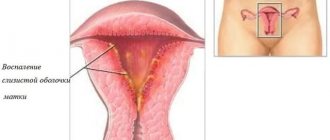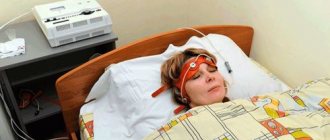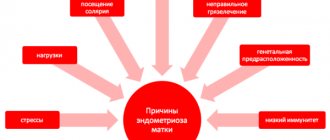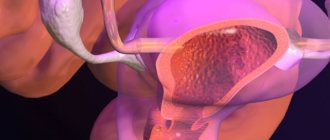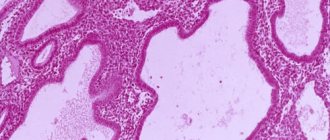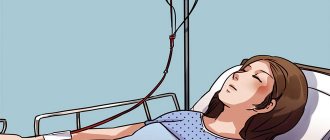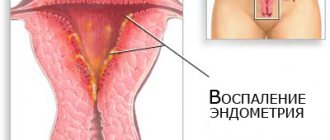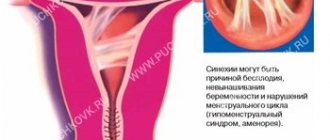In case of a chronic version of the inflammatory process in the uterine cavity, the optimal and effective therapeutic effect is physical factors that will help restore the impaired functional activity of the endometrium and prevent the uterine form of infertility.
Physiotherapy for endometritis is used at all stages of therapy: a positive effect on tissue reduces the risk of complications and ensures the restoration of menstrual function. Complex treatment with the inclusion of hardware techniques in the treatment regimen can speed up recovery and restore the woman’s ability to conceive a baby.
Physical Therapy Treatment Options
Specific methods of exposure should be determined by the doctor based on the clinical picture of the disease.
This method of hardware exposure uses a high-frequency electromagnetic field, usually 40 or 27 MHz. The effect of the procedure is the formation of conduction and absorption current. As a result, thermal energy is generated, which penetrates the endometrial tissue. UHF allows you to achieve uniform deep heating of the affected uterus.
UHF device
UHF is effective for chronic endometritis, when there are no foci of acute inflammation in the uterus. Exposure is contraindicated in the following cases:
- the presence of precancerous conditions or detection of oncological changes;
- serious pathologies of the cardiovascular system;
- hypertension;
- pregnancy.
The UHF course should not last more than two weeks, since too long exposure can provoke the development of adhesions in the uterus.
Electrophoresis
This method is based on the local effect of electric current on the affected organs using medications. Using electrophoresis, it is possible to deliver a therapeutic agent directly to the diseased area of internal organs as quickly as possible.
From a physics point of view, the method looks like this:
- Polar electrodes are applied to the skin in the uterine area;
- gauze is impregnated with the desired medicine and the electrodes are wrapped in it;
- The device turns on, weak currents begin to deliver the drug to the pelvic area and uterus.
The course of treatment usually lasts 10 - 15 days, the duration of one session should not exceed 20 minutes.
Electrophoresis is most often used in the treatment of endometritis, since it can significantly relieve endometrial swelling and stop the development of the inflammatory process.
Magnetotherapy
The method is based on the proven ability of a magnetic field to influence the physical and chemical characteristics of electrolytes in the human body, changing the rate of biochemical reactions.
The purpose of magnetic therapy for endometritis is aimed at preventing the occurrence and development of adhesions in the uterus and appendages.
Magnetotherapy
This method is especially effective in combination with other physiotherapeutic techniques: massage, electrophoresis, balneological treatment.
A contraindication to the use of magnetic therapy is a tendency to uterine bleeding.
Decimeter therapy
The impact occurs using ultra-high frequency electromagnetic waves (300 - 3000 MHz). They have a warming effect, relieve inflammation and improve blood circulation in the vessels of the uterus. Also, decimeter waves can increase vascular permeability and increase the body's defenses. Decimeter waves are indicated for chronic endometritis. The course of therapy lasts 10 days, the duration of one procedure is 15 - 20 minutes.
Laser therapy
This type of treatment is aimed at destroying adhesions in the uterine cavity or appendages. Low-energy laser radiation for endometritis is directed to the area above the womb.
Indications for acute and chronic endometritis
Before starting treatment, it is important to correctly determine the stage of the disease. In the acute form of the disease, physiotherapy is contraindicated until the condition has stabilized, since any heating or other type of exposure can trigger the development of the inflammatory process.
If a patient is diagnosed with chronic endometritis, the possibility of including physiotherapy in the complex of treatment measures will depend on its type. Thus, in the case of an atrophic type of pathology, when the endometrium becomes thinner and ceases to renew itself, physiotherapeutic procedures are necessarily included in the overall treatment regimen. In the hyperplastic form, i.e. with diffuse or focal proliferation of glandular structures in the endometrium, physiotherapy is contraindicated.
Physiotherapeutic treatment is prescribed only after determining the condition of the endometrium of the uterus
In general, hardware treatment is indicated in the following cases:
- symptoms of thinning and atrophy of the uterine endometrium during the chronic course of the disease;
- in the chronic form of the disease in remission;
- infertility caused by pathological changes in the uterine endometrium;
- subacute form of the disease;
- detection of a focus of inflammation during a restorative course of treatment.
The choice of technique is determined by a correct assessment of the benefits of the procedures and possible complications, therefore the treatment complex is selected by the attending physician strictly individually.
Beneficial physical therapy for endometritis
Endometritis is an inflammation of the inner mucous membrane of the uterus. Treatment of this disease is always complex. It is based on antibacterial therapy, since the pathology is usually provoked by pathogenic flora that has penetrated the uterus. Hormones, vitamin complexes, and immunomodulators are also used in therapy. In order to achieve complete recovery and restore the reproductive function of the female body, physiotherapy methods are also widely used in medical practice.
Read in this article
Physiotherapy for endometritis
Before the start of the course, the woman is given a full medical examination. The choice of methodology is influenced by the following factors:
- accurate clinical diagnosis;
- cause of inflammation;
- pathogen;
- research results.
Important! It is best to start treatment immediately after the end of your period.
Mud therapy
The best results are obtained by using silt mud mined near the city of Saki.
The mud contains a large amount of hydrogen sulfide and mineral components. In addition, it is rich in bacteriophages - living microorganisms that suppress the proliferation of pathogenic microflora - and substances of biological origin similar in structure to the hormone folliculin, which improves the functionality of the ovaries.
Methods of using mud:
- external and internal (tamponing) applications;
- combined use of mud compresses with other types of physiotherapy.
Recommended course – 10…20 sessions.
Pulse current
One of the types of electric current treatment. The most common method is the effect on the tissue of the cervix.
Thanks to the use of pulsed currents, the following problems are solved:
- blood supply to uterine tissue improves;
- the development of the endometrial layer improves;
- the ovaries are stimulated.
The procedure is performed in a gynecological chair. Pain is not typical for it, but may be accompanied by the appearance of unpleasant sensations in the affected area.
Duration of the course – 7…10 sessions.
Electrophoresis for endometritis
One of the types of physiotherapy, which is based on the administration of medicines using electric current.
During the session, electrodes are applied to the surface of special pads soaked in the selected medication. The area of influence is the lower abdomen, lumbar region.
In the treatment of endometrial inflammation, the following types of electrophoresis are used:
- with zinc – relieves inflammation well;
- with novocaine – eliminates characteristic pain, has a targeted effect;
- with potassium iodide – promotes restoration and growth of the endometrium, often prescribed as a preparatory step for the IVF procedure;
- with hydrocortisone – used for endometritis of non-infectious origin.
The procedure is painless. Session duration is 15 minutes. The total duration of the course is 7...15 visits.
Balneotherapy
Balneotherapy is a treatment with mineral waters. For endometritis, taking hydrogen sulfide, radon and iodine-bromine baths is beneficial.
Phonophoresis
Phonophoresis is essentially similar to electrophoresis, only the delivery of drugs is ensured by exposure to radiation.
Goals of physical therapy for endometritis
Physiotherapy for chronic endometritis is prescribed for certain purposes. Conducting sessions contributes to:
- relieving symptoms of inflammation and preventing irreversible changes in the basal layer;
- restoration of ovarian functions for subsequent adjustment of hormonal levels;
- improvement of local blood circulation and metabolic processes, for subsequent restoration of endometrial functions;
- creating favorable conditions for the development and successful course of gestation;
- reducing the risk of developing cancer pathologies.
Physiotherapy procedures are prescribed only after the symptoms of the acute period have been eliminated. The main goal of therapy is to improve local blood flow, anti-adhesive and anti-inflammatory effects.
Useful video
About physiotherapy for chronic endometritis, watch this video:
Acute endometritis develops due to infections. It can be purulent, catarrhal. The reasons may lie in abortion, examination procedures, and sometimes postpartum. Symptoms: fever, chills, pain. The treatment is long-term, antibacterial.
Acute adnexitis develops due to hypothermia, bacteria and other reasons. Symptoms can be either hidden or manifest as severe pain. Treatment can be carried out in a hospital or at home.
Trichomonas vaginitis develops under the influence of Trichomonas parasites. The disease has unpleasant symptoms and brings a lot of discomfort. It also provokes urethritis. The woman should be treated as quickly as possible.
Almost invisible, acute cervicitis can cause a lot of trouble. The reasons lie in infections, weakened immunity, and poor hygiene. Symptoms appear if cervicitis is a reflection of another disease. The treatment is complex.
Contraindications
Physiotherapeutic methods of influencing the endometrium are prohibited from being used in the following cases:
- identified hyperplasia and hypertrophy of the endometrium in the chronic course of the disease;
- polyps in the uterus or cervical canal, especially those caused by endocrine disorders;
- neoplasms in the organs of the genitourinary system of a benign nature;
- ovarian cysts;
- the presence of foci of acute inflammation with a risk of suppuration;
- tuberculous lesions of the reproductive organs;
- suspicion of cancer of any organs;
- severe systemic diseases of the cardiovascular system, liver or kidney damage, thyroid problems.
Goals of physical therapy for endometritis
Physical methods of treatment have shown high effectiveness in the treatment of endometritis, since they have a beneficial effect on the affected tissue, allowing one to avoid complications and restore the normal menstrual cycle. In addition, the combination of modern hardware techniques makes it possible to restore reproductive function in case of complications.
The use of physiotherapy has the following goals:
- relieving inflammation in the endometrium, which can prevent pathological processes in the basal layer;
- normalization of ovarian function and restoration of hormonal levels;
- improvement of the condition of the vessels of the uterus and endometrium, normalization of blood supply to the organs of the genitourinary system;
- activation of metabolism in the uterus to increase the functionality of the endometrium;
- restoration of the functioning of endometrial receptors to normalize the process of hormone production;
- improving reproductive function, creating prerequisites for successful conception and normal pregnancy;
- reducing the risk of occurrence and development of oncological processes;
- prevention of diseases of the genitourinary system.
